Lately there have been many learning programs that have started to implement gaming elements to help drive home main learning points and to get the learner thinking about the material from another perspective. The concept of using games to accompany lessons likely started in the K-12 environment, but has since found its way into professional organizations, and now into elearning.
Gamification in elearning often is in the form of badges, points, certificates, and other forms of rewards. These components are rather easy to implement and are often built right into a learning management system.
Since modern ways of training, such as elearning, are perceived as being rather contemporary (it certainly has seen an increase in popularity in recent years), gamification is often viewed as having a similar history.
However, if we really analyze the roots of gamification, we can see that its roots go all the way back to the early 1900s! Gaming elements were not necessarily part of the education industry at this point, but used more with the intent of marketing and sales.
Slowly over time, rewards and loyalty programs made their way into other elements of life, such as video games in the 1980s, eventually making the natural transition to education realm as gaming was used to help students.
The infographic below, created by Technology Advice, highlights some of the key moments in the history of gamification. It’s fascinating to see how today’s points and badge systems first started off as a way to get people to spend more money and to foster a sense of brand loyalty.

Justin Ferriman
@LearnDashLMS








